Su Puta

Entrance to Su Puta |
The breweries are pretty close together here in Panevežys. Ten minutes after leaving Piniavos we arrive at the next brewery, Su Puta. And let me at once add that in Lithuanian the name means "with foam." I ask Vidmantas whether he knows what it means in Spanish, and he answers with a sigh that "Yes, I know. Everyone keeps telling me." So I shut up and follow him through the gate. (This is part 3 of the Lithuanian brewery tour 2015.)
We're met by the brewer's wife, Elena, because the brewer is busy brewing. Normally, this would be a great opportunity to show visitors the brewing in progress, but she doesn't do that. When Arturas, the brewer, is mashing he locks the door and will not let anyone in. If Elena or anyone else bangs too hard on the door at this point, the foam will collapse, she says. "And then it will no longer be Su Puta [with foam]," I quip. Vidmantas translates this, chuckling, but it's met with stony-faced silence. So apparently this is not a joking matter. Which I perhaps should have guessed, because similar beliefs were held with great seriousness by farmhouse brewers in Scandinavia, too.
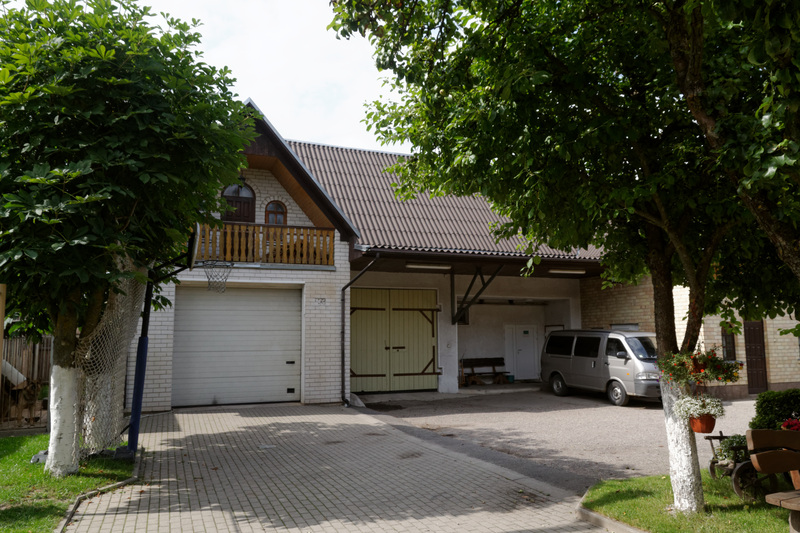
The brewery |
The brewery has the usual layout: a farm yard with the house on one side, and the brewery directly opposite, both buildings in brick. Elena explains that the brewery used to be the barn. They started brewing in one part of the barn, but eventually the brewery expanded to fill the entire building. So this literally is a farmhouse brewery, and now I realize that probably the exact same thing happened at Piniavos and the other places. They are all farms where the barn has been converted into a brewery.
We enter the brewery and Elena shows us the boiler room. The brewery, it turns out, is wood-fired. Smiling mischievously, she leads us into a tiny room up under the roof, and asks if I know what it is. The room is filled with dried birch branches with the leaves still on. I look around wondering what they might use them for, but eventually give up.
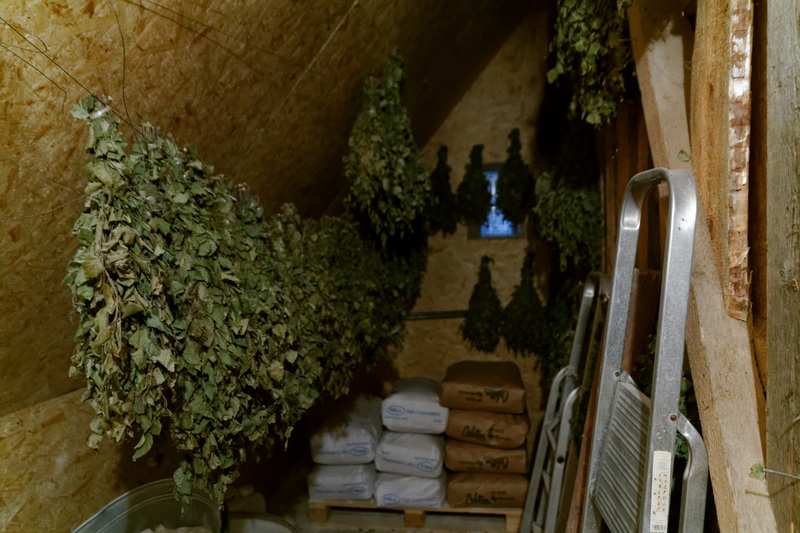
Birch twigs |
They make birch infusion for cleaning the brewing vessels, Elena explains. They did it this way back when they were brewing in wood, and still do it now that they're brewing in steel. This is interesting, because in Scandinavia juniper infusion was used for the same thing. I tell Elena this, and she nods. Yes, you can use juniper, too, she says.
By now, Arturas has finished mashing and we can enter the brewery itself. It's astonishingly similar to the one at Piniavos, down to the hop tea cooker in the corner. So clearly they brew raw ale just like Piniavos. I ask Elena, and she confirms that the brewery was custom-built locally for them. We go into the next room, which holds open fermenters with wort that hasn't started fermenting yet.
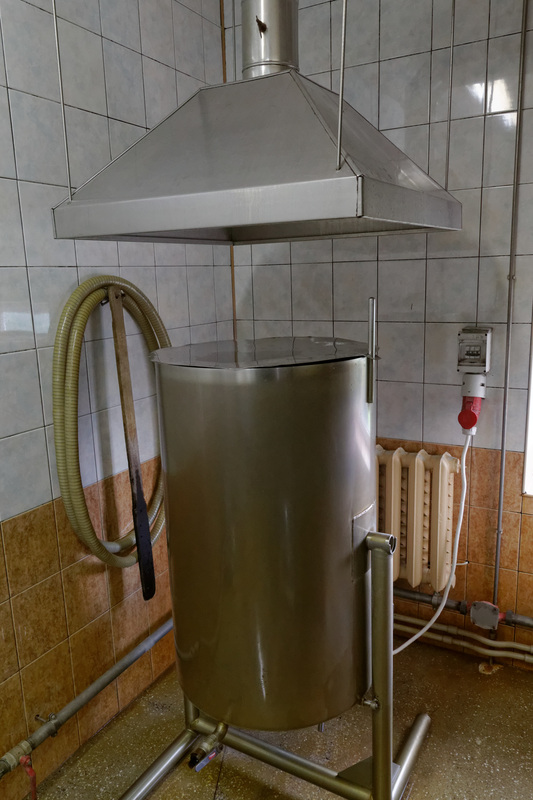
The hop tea cooker |
We leave the brewery, and go out to a small garden pavillion, where Elena has set out some home-made snacks: rye bread, ham, sausage, cured cheese, and cucumbers. It's all delicious. Then, of course, the beers come out. At the moment, Su Puta mainly brews three beers:
- Su Puta Putos Lengvas, 5.8%. A normal šviesusis (Lithuanian pale), hopped with wild hops. An odd beer with herbal candy flavours and fruity butterscotch ending in a long drawn-out dusty dry strawy finish. A very approachable and drinkable beer for something so exotic as raw Lithuanian farmhouse ale with wild hops. My wife liked it when she tried it in Vilnius.
- Su Puta Paliūniškis Medutis, 5.5%. A honey beer with more honey flavour than what's usual in this type of beer. An unusual beer, with notes of peas, resin, spices, earth, nuts. Surprisingly complex.
- Su Puta Senolių Senovinis, 6.9%. This is the star of the show, because in this beer they use the family yeast. Strong banana and blueberry aroma with rye notes and a peppery herbal finish. I had this in Vilnius and thought it was pretty good. At the brewery it's a lot better.
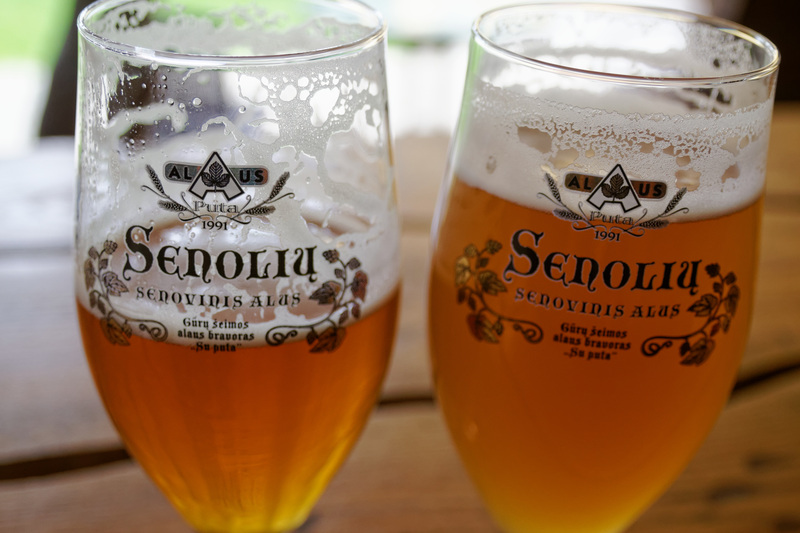
Senolių on the right, Medutis on the left |
Elena sees me pondering the Senolių, and says "it tastes like a German hefeweizen, doesn't it?" I nod. "There's no wheat in it," she says. "The flavour is all from the yeast." They have the yeast from grandfather Jonas and are always very careful with it, knowing that if it goes bad there is nowhere to turn for help. They keep yeast from several different brews, and only use the best of them. They are very careful with the sanitation. "My husband often tells me, 'your kitchen is not as clean as the brewery'," says Elena with a smile.
The malts they use are mostly Lithuanian pilsner malts from the Viking Malt plant here in Panevežys. They also use some Czech malts and darker malts from abroad. I ask Elena about this. How can the dark malts be traditional if they used to sun-dry the malts? Well, she explains, in the old days people might darken some of the malts in the oven to give colour to the beer. Which is exactly what Rasmus told me, in response to the same question, 1235 kilometers away in Hornindal.
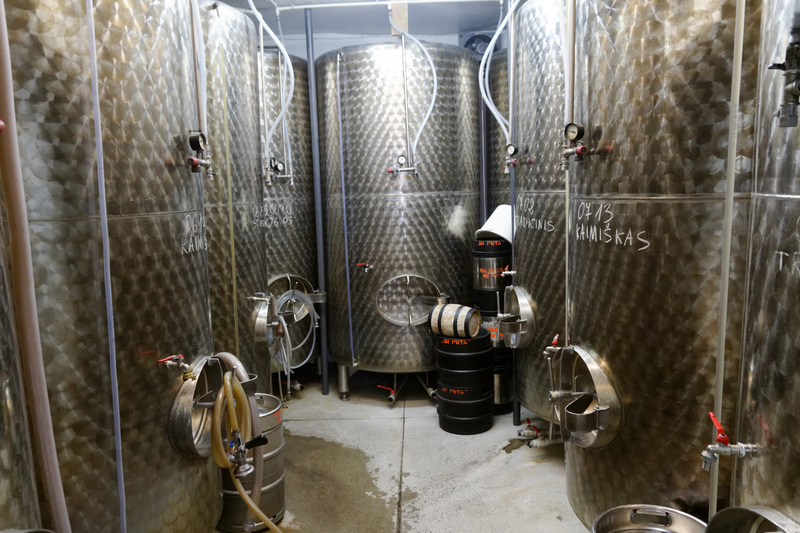
Maturation tanks |
Elena starts telling stories about the family, beginning with the time when they lived in the Kupiškis area. Grandfather Jonas was famous in the area as a home brewer. People came to him asking him to brew for weddings and other big celebrations. Their home, she says, was the second most important house in the village, after the church, because it was both the smithy and the brewery. So people would gather there.
The family moved to Panevežys, a bigger town, to find work, but kept up the family tradition of brewing. Eventually, in the early 90s, they went commercial, opening the brewery. Talking to Elena it's clear that these people don't just work as brewers. They are brewers. In old family photos there's never any wine or vodka, always just beer. Grandfather, she says, used beer as medicine against all diseases, and even in shampoo. He was very involved with the brewery all his life. Even days before he died, when he could no longer get up, he was still concerned for the brewery, saying "check this, clean that," and so on. Elena says they're very conscious of keeping an old tradition alive, and happy to be doing it. They think the current scale of the brewery is just right, and don't really want to change anything.
I sure hope they don't.
Similar posts
Dundulis
From Panevežys we drove to Biržai to visit a completely different type of brewery
Read | 2016-07-31 12:01
Davra
About a kilometer from Jovaru Alus, in Pakruojis itself, lies another brewery, called Davra
Read | 2016-08-28 14:12
Jovaru Alus
As a favour to me Vidmantas had left the most interesting brewery as the last of the day, so that we could spend more time there
Read | 2016-08-21 14:14
Comments
Martynas - 2016-06-19 12:57:21
Brilliant read as always! I have been to Su Puta's beer kiosk outside the brewery several times, but never managed to get into the brewery itself - they would be aout and about, working, brewing or delivering beer - as I understand, only the family members are involved in all parts of the operation.
Great to read all these interesting details. Here's to the Gradfather Jonas, the best brewer of the village.
Joris - 2020-04-23 09:51:45
Hey Lars, Joris from Alaus Biblioteka (Vilnius, Lithuania) writing here.
Dunno if you visited us ever again (and remember), but last time you've been here and I had a chance to meet you, we had a little talk about lithuanian farmhouse beers, including Dundulio Moko Maukas mistinis (steinbier) which you had at the moment. Also, while showing off cooling room where beers are kept, we talked about "Su Puta" brewery, "Senoliu" ale and Gurai family yeast culture. I really remember, that you mentioned the fact, that the culture itself have been researched and the results are here - if I am not mistaken, it was mentioned, that it includse atleast different three strains of brettanomyces.
It would be very helpful for my thesis if you could share some more information about the research and or give some directions, where I could find some information-papers regarding this yeast.
Thanks!